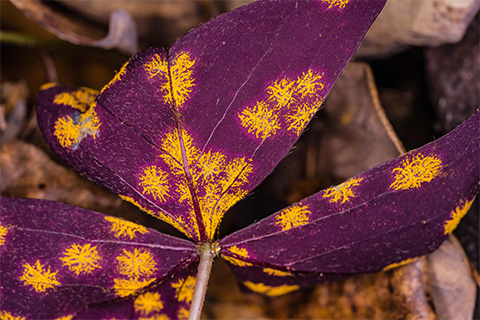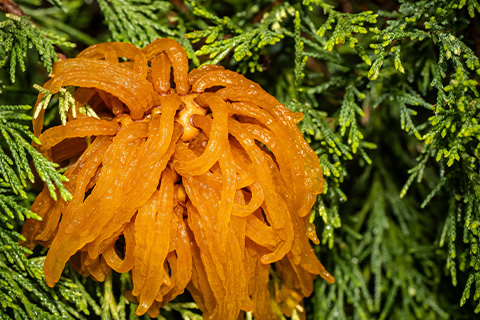10/31/2025
Breaking the Rust Cycle
Dr. Janna Beckerman

Rust diseases are among the most recognizable plant pathogens (Figure 1), but they remain some of the most difficult to manage. They attack a wide variety of plants, including conifers, broadleaf trees, shrubs, perennials, bedding plants, ferns, grasses and bulbs.
Figure 1. Cedar-hawthorn rust on juniper—a gateway rust into the field of plant pathology.
The first signs of infection usually appear as pale spots on leaves, which later develop into spore-filled pustules. These often form on the undersides of leaves (Figure 2) and can range in color from yellow, white, brown or black, though they’re most often the distinctive rusty orange that gives the disease its name. When rust becomes severe, leaves may yellow and fall prematurely, depriving plants of their energy and weakening or even killing them. Although leaves are the most common infection site, stems, flowers and fruit can also be affected.
Pathogen characteristics
Rust fungi are unique in how they complete their life cycles, with some rusts infecting only a single host (e.g., snapdragon rust) to members of a family (hollyhock rust infecting many, but not all, members of the Malvaceae family) to rusts that are specific to infecting some ferns, fir and fuchsia. Evolution is bizarre!
Autoecious rusts complete their entire life cycle on a single host, infecting and reinfecting the host plant. Snapdragon, hollyhock rust (which affects hollyhock and related genera in the Malvaceae family) and sunflower rust are familiar examples.
 More complicated are the heteroecious rusts that infect taxonomically distinct hosts not in the same family. Cedar-apple rust—or more accurately, juniper rusts—illustrates this relationship well, cycling between junipers (Figure 1) and various members of the rose family, such as apple, pear, crabapple, hawthorn or serviceberry (Figure 3). The pathogen would literally die in the absence of the juniper or rose family host.
More complicated are the heteroecious rusts that infect taxonomically distinct hosts not in the same family. Cedar-apple rust—or more accurately, juniper rusts—illustrates this relationship well, cycling between junipers (Figure 1) and various members of the rose family, such as apple, pear, crabapple, hawthorn or serviceberry (Figure 3). The pathogen would literally die in the absence of the juniper or rose family host.
Figure 2. Native plants, like this ironweed, are host to hundreds of rusts.
Fuchsia rust, which cycles between fuchsia/fireweed and fir, regularly plagues growers wherever fir and/or fireweed are grown. Many North American native annuals and perennials are hosts of heteroecious rusts, including aster, bee balm, cup-plant, goldenrod, ironweed and oxalis. Alternate hosts include native two- to three-leaf pines and prairie grasses—and even corn!
Environmental conditions
Rust fungi thrive where mild temperatures, high humidity and poor air circulation come together. Morning dew and greenhouse condensation are particularly conducive, as they supply the constant moisture required for spores to germinate and invade plant tissue. These environmental conditions make outbreaks especially common in crowded plantings and in poorly ventilated greenhouse or shadehouse environments.
Figure 3. Serviceberry is a host of many different juniper rusts. This infection was caused by cedar-quince rust.
 Management approaches
Management approaches
Because rust fungi are persistent, managing them requires a combination of cultural and chemical strategies. Some key cultural controls include:
- Use of resistant varieties. See the Purdue Extension bulletin "Disease-resistant Annuals and Perennials in the Landscape" by GOING HERE.
- Improve plant spacing for airflow to allow leaves to dry quickly, preventing germination and infection of spores.
- Manage condensation in greenhouses with heating and ventilation.
- Preventative applications of fungicides.
- Understanding the life cycle of the rust disease to control.
- The timing of fungicide use depends on whether the rust is autoecious or heteroecious (“Auto” = one plant; “Hetero” = two plants). Fungicide use depends on the kind of rust:
- With autoecious rusts (like those on snapdragons and hollyhocks), the same plant keeps getting reinfected, requiring fungicide protection any time the environment favors rust.
- With heteroecious rusts, the fungus cycles between two different plants. Growers may need to protect the main crop of interest, or sometimes both hosts, to break the cycle.
Cedar-apple rust (Gymnosporangium juniperi-virginianae) alternates between junipers and rose family members, with the disease spreading only from rosaceous hosts to junipers rather than directly reinfecting apple/crabapple/hawthorn/serviceberry. This means a crabapple will not infect another crabapple, but can readily infect a juniper within about a half-mile radius!
 To manage this disease, begin with Broadform fungicide or other FRAC group 7+11 fungicide with a spreader-sticker when rose family plants are at the pink-bud stage, and then switch to a FRAC 3 fungicide after petal fall. Avoid spraying during bloom to protect pollinators. Spray protection of rose family hosts should continue until terminal growth is set or junipers stop producing spores. If junipers are the crop of interest, begin spraying mid-summer until leaves on the rose family host have dropped.
To manage this disease, begin with Broadform fungicide or other FRAC group 7+11 fungicide with a spreader-sticker when rose family plants are at the pink-bud stage, and then switch to a FRAC 3 fungicide after petal fall. Avoid spraying during bloom to protect pollinators. Spray protection of rose family hosts should continue until terminal growth is set or junipers stop producing spores. If junipers are the crop of interest, begin spraying mid-summer until leaves on the rose family host have dropped.
Figure 4. Ornamental oxalis is host to southern rust. The alternate host is corn.
For fuchsia rust, which has a repeating stage on fuchsia and fireweed, season-long control is again necessary wherever fireweed grows nearby.
Despite these complications, there’s at least one reassuring piece of news: Fungicide resistance in rust fungi is extremely rare. Rotating fungicides between Broadform fungicide (or other FRAC 7+11 fungicide) and FRAC 3 fungicides have proven to be an effective management strategy that keeps rust fungi in check. Use of a spreader-sticker improves coverage and performance against rust fungi. GT
Dr. Janna Beckerman is a Green Solutions Team Specialist for Envu. If you encounter issues, we’re here to support. Find me at janna.beckerman@envu.com.